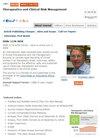慢性肾病和 COVID-19 变异型 Omicron 住院患者的临床表现和疗效
IF 2.8
3区 医学
Q1 Pharmacology, Toxicology and Pharmaceutics
引用次数: 0
摘要
目的:调查慢性肾脏病(CKD)和新型冠状病毒(SARS-CoV-2)感染住院患者的临床特征,并确定导致死亡的潜在风险因素:这是一项回顾性研究,研究对象为2022年12月1日至2023年2月28日期间在中国人民解放军总医院第一医学中心住院的慢性肾脏病患者。所有患者均感染了 SARS-CoV-2。我们分析了患者的临床特征,并将患者分为存活组和死亡组,比较两组的特征。我们使用 Cox 回归分析来确定影响患者预后的风险因素:本研究共纳入 406 名患者,其中包括 298 名男性(73.4%)。患者平均年龄为 80.5 (67.0, 88.0) 岁,平均肾小球滤过率 (eGFR) 为 50.3 (25.0- 79.0) mL/min/1.73m²。共有 158 人在住院期间死亡,死亡率为 38.9%。死亡组的肾功能比存活组差(P < 0.001)。与存活组相比,死亡组患者的 COVID-19 病变更严重,CKD 分期更高(所有 P 值均为 0.001)。多变量 Cox 回归分析确定了影响患者死亡率的几个风险因素,包括男性、入院时静息心率(RHR)较高、呼吸困难、淋巴细胞计数(Lym)较低、国际标准化比值(INR)较高、急性生理学和慢性健康评估 II(APACHE II)评分较高、心力衰竭以及在患病期间需要机械通气:结论:感染 SARS-CoV-2 的慢性肾脏病住院患者死亡率相对较高(38.9%)。结论:感染了 SARS-CoV-2(38.9%)的慢性肾脏病住院患者的死亡率相对较高(38.9%),此外,还观察到 eGFR 降低与死亡风险增加之间存在明显的相关性:SARS-CoV-2、估计肾小球滤过率、呼吸衰竭、死亡率本文章由计算机程序翻译,如有差异,请以英文原文为准。
Clinical Presentation and Outcomes of Hospitalized Patients with Chronic Kidney Disease and COVID-19 Variant Omicron
Purpose: To investigate the clinical characteristics of hospitalized patients with chronic kidney disease (CKD) and novel coronavirus (SARS-CoV-2) infection and identify potential risk factors that contribute to mortality.
Patients and Methods: This is a retrospective study, conducted on patients with CKD who were admitted to the First Medical Center of the People’s Liberation Army General Hospital between December 1, 2022, and February 28, 2023. All patients were also infected with SARS-CoV-2. We analyzed the clinical characteristics of patients, and the patients were categorized into a survival group and a death group whose characteristics were compared. Cox regression analysis was used to identify risk factors that affected patient prognosis.
Results: A total of 406 patients were enrolled in this study, including 298 males (73.4%). The average age was 80.5 (67.0, 88.0) years, and the patients had an average estimated glomerular filtration rate (eGFR) of 50.3 (25.0– 79.0) mL/min/1.73m². A total of 158 individuals died during hospitalization, resulting in a mortality rate of 38.9%. Renal function was worse in the death group than in the survival group (P < 0.001). Patients in the death group had more severe COVID-19 disease and higher CKD staging than those in the survival group (all P values < 0.001). Multivariate Cox regression analysis identified several risk factors that affected patient mortality, including being male, a higher resting heart rate (RHR) upon admission, dyspnea, a low lymphocyte count (Lym), a high international standardized ratio (INR), a high Acute Physiology and Chronic Health Evaluation II (APACHE II) score, heart failure, and the need for mechanical ventilation during the disease.
Conclusion: Hospitalized patients with CKD who were infected with SARS-CoV-2 (38.9%) had a relatively high mortality rate (38.9%). Furthermore, a marked correlation was observed between a reduced eGFR and an increased risk of mortality.
Keywords: SARS-CoV-2, estimated glomerular filtration rate, respiratory failure, mortality rate
Patients and Methods: This is a retrospective study, conducted on patients with CKD who were admitted to the First Medical Center of the People’s Liberation Army General Hospital between December 1, 2022, and February 28, 2023. All patients were also infected with SARS-CoV-2. We analyzed the clinical characteristics of patients, and the patients were categorized into a survival group and a death group whose characteristics were compared. Cox regression analysis was used to identify risk factors that affected patient prognosis.
Results: A total of 406 patients were enrolled in this study, including 298 males (73.4%). The average age was 80.5 (67.0, 88.0) years, and the patients had an average estimated glomerular filtration rate (eGFR) of 50.3 (25.0– 79.0) mL/min/1.73m². A total of 158 individuals died during hospitalization, resulting in a mortality rate of 38.9%. Renal function was worse in the death group than in the survival group (P < 0.001). Patients in the death group had more severe COVID-19 disease and higher CKD staging than those in the survival group (all P values < 0.001). Multivariate Cox regression analysis identified several risk factors that affected patient mortality, including being male, a higher resting heart rate (RHR) upon admission, dyspnea, a low lymphocyte count (Lym), a high international standardized ratio (INR), a high Acute Physiology and Chronic Health Evaluation II (APACHE II) score, heart failure, and the need for mechanical ventilation during the disease.
Conclusion: Hospitalized patients with CKD who were infected with SARS-CoV-2 (38.9%) had a relatively high mortality rate (38.9%). Furthermore, a marked correlation was observed between a reduced eGFR and an increased risk of mortality.
Keywords: SARS-CoV-2, estimated glomerular filtration rate, respiratory failure, mortality rate
求助全文
通过发布文献求助,成功后即可免费获取论文全文。
去求助
来源期刊

Therapeutics and Clinical Risk Management
HEALTH CARE SCIENCES & SERVICES-
CiteScore
5.30
自引率
3.60%
发文量
139
审稿时长
16 weeks
期刊介绍:
Therapeutics and Clinical Risk Management is an international, peer-reviewed journal of clinical therapeutics and risk management, focusing on concise rapid reporting of clinical studies in all therapeutic areas, outcomes, safety, and programs for the effective, safe, and sustained use of medicines, therapeutic and surgical interventions in all clinical areas.
The journal welcomes submissions covering original research, clinical and epidemiological studies, reviews, guidelines, expert opinion and commentary. The journal will consider case reports but only if they make a valuable and original contribution to the literature.
As of 18th March 2019, Therapeutics and Clinical Risk Management will no longer consider meta-analyses for publication.
The journal does not accept study protocols, animal-based or cell line-based studies.
 求助内容:
求助内容: 应助结果提醒方式:
应助结果提醒方式:


